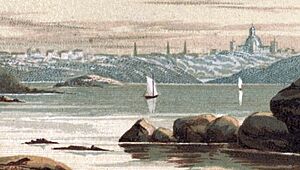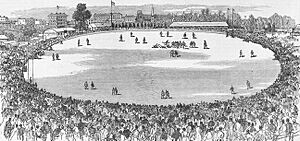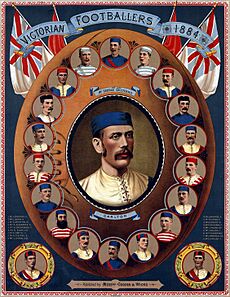George Coulthard facts for kids
Quick facts for kids
George Coulthard
|
|
|---|---|
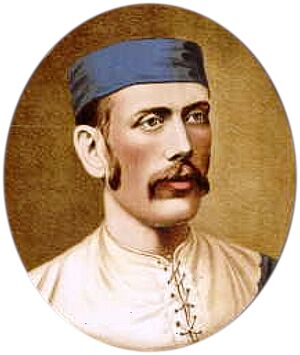
Coulthard wearing a Carlton Football Club guernsey and cap
|
|
| Born | 1 August 1856 Camberwell, Victoria, Australia
|
| Died | 22 October 1883 (aged 27) Carlton, Victoria, Australia
|
| Resting place | Melbourne General Cemetery, Victoria |
| Occupation |
|
| Spouse(s) |
Letitia Jackson
(m. 1880) |
| Children | 2 |
George Coulthard (born August 1, 1856 – died October 22, 1883) was an amazing Australian sportsman. He was a talented cricketer, an umpire, and a star Australian rules footballer.
Born and raised on a farm near Melbourne, Victoria, George helped lead the Carlton Football Club to win championships in the early days of the Victorian Football Association (VFA). He was also a key player for the Victorian team that was very strong in the first games between different colonies. Many people at the time thought George was the best player ever seen in Australian football. He was fast, could play many positions, and had great skills. Today, he is known as the game's "first true superstar" and is in the Australian Football Hall of Fame.
As a professional cricketer, he played for the Melbourne team. He also played for Victoria in five important first-class games between colonies. He even played one Test match for Australia against England in 1882. George also became the youngest ever Test umpire at age 22. He is famous in cricket for a big event called the Sydney Riot of 1879. This happened in 1879 when he made a controversial decision as an umpire.
George Coulthard was very well-known across Australia because of his sports achievements. Outside of sports, he owned a tobacco and sports shop. He also became famous for surviving a shark attack, fighting a famous boxer named Jem "The Gypsy" Mace, and for a dream he supposedly had about a horse race. He is also known as Australian football's first "man in white" because he umpired a game in 1880 wearing an all-white uniform, which is now traditional. In 1882, while umpiring for the England cricket team, George became sick with tuberculosis. He sadly passed away the next year at just 27 years old.
Contents
Football Career
Carlton's Star Player
| George Coulthard | |||
|---|---|---|---|
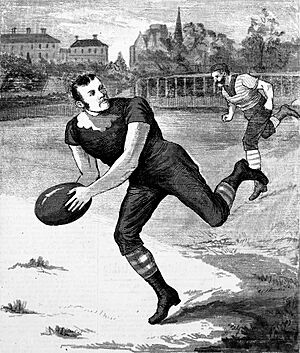
Coulthard running with the ball against Geelong at the East Melbourne Cricket Ground on 17 July 1880
|
|||
| Personal information | |||
| Original team | Carlton Imperial | ||
| Career highlights | |||
|
|||
George Coulthard started playing club football in 1874 for Carlton Imperial. This was a junior team linked to the main Carlton Football Club. He was great at kicking goals for the Imperials. In 1876, he joined the senior Carlton team, which was very strong in Victorian football. He started as a follower and was seen as a "rising and very promising player." Carlton was at the top of the ladder that year. They hoped to win their fourth championship in a row. But in a key game against Melbourne, a controversial umpire call gave the trophy to Melbourne.
The Victorian Football Association (VFA) started the next year, with Carlton as one of its first twelve clubs. Even though George played in different positions during the 1877 VFA season, he still kicked eight goals, tying for the most on Carlton's team. He was famous for his amazing runs with the ball, sometimes going 100 meters down the field. People said he was "unequalled" at this special style of play.
In the middle of the season, Carlton made history by playing the first intercolonial football games in Australia. They traveled to Sydney in New South Wales to play against the Waratahs, a local rugby club. They played two matches: one using rugby rules and one using Australian rules. As expected, each club won the game played by its own rules. George was one of the two Carlton players who adapted best to rugby. The clubs met again in Melbourne and switched codes again. George played very well in both games. He even briefly joined the Waratahs to play rugby. He quickly became a star in rugby, scoring all five goals and four tries in his second and last game for them.
Even though he only played two rugby games for the Waratahs in 1877, George scored more goals than any other player that season. He also tied for the most tries. Decades later, people still remembered George for "showing the Rugby men how their game should be played."
Shark Attack Survival
After playing against Carlton, the Waratahs started playing Australian rules football. For a while, it seemed like Australian rules might become the most popular sport in Sydney. During this time, George Coulthard was invited to Sydney to help promote Australian rules. On September 15, 1877, soon after he arrived, George went on a fishing trip in Sydney Harbour with some local footballers. Their boat was anchored near Shark Island. George was sitting on the side of the boat with his coat hanging in the water. Suddenly, "a monster shark, 13 feet long" pulled him overboard! The shark grabbed his coattails and dragged him "some ten or twelve feet" underwater. The coat then ripped off his body. George kicked at the shark and swam back to the surface. His friends quickly helped him jump back into the boat. This event was called "one of the most marvellous escapes from a fearful death" ever seen.
George was very shaken by what happened. He returned to Melbourne within a week and started playing for Carlton again. There were rumors that Carlton paid him to come back, but the club said he returned because of a disagreement with his friends in Sydney. Still, the shark attack became a famous story. People said it was the reason George left Sydney, which supposedly stopped Australian rules from becoming the most popular football game there.
Champion of Victoria
Back in Victoria, Carlton was already seen as the winner of the 1877 championship. This was their fifth championship in seven years. George was very important in keeping Carlton at the top. He was named one of the VFA's best defensive players. Carlton was also the best team early in the 1878 VFA season, with George playing outstandingly. However, the Geelong team became very strong in 1878 and would dominate the competition for many years. George finished the season with 18 goals, the most of any player that year. He was especially praised for his skills in the ruck (a key position).
George was Carlton's best player in their first game of the 1879 VFA season. They won 4–0 against Albert Park. George scored a goal using a clever dodging move that made his opponents look "like a lot of demented geese." In July, the Victoria team beat South Australia in Melbourne. This was the first football game between two colonies. George kicked two goals for Victoria and was the best player on the field. He also led the way when Victoria easily beat South Australia again a few days later. The next month, at the Melbourne Cricket Ground (MCG), Carlton beat Melbourne 3–0 in the first club football game played at night under electric lights. George kicked two of those goals. He ended 1879 with a record 21 goals, seven more than anyone else. At the end of the season, a newspaper said:
There can be no two opinions as to who is entitled first mention—George Coulthard, of Carlton. Back, forward, or following, and nowhere out of place, the grandest player of the day, it is doubtful if for general excellence his equal has ever been seen in Victoria.
George kicked all five goals in the first game of the 1880 VFA season. Carlton was still undefeated in June when they won another game against Melbourne. This game was a special "testimonial match" for George, and he played brilliantly. In July, he umpired a game between Melbourne and the Norwood Football Club (from South Australia) wearing the now-traditional all-white umpiring uniform. Because of this, he is known as football's first "man in white." Later that month, in a big game against the reigning champions Geelong, George fainted after an opponent accidentally injured him. He tried to confront the player but was pulled back by a police officer and taken off the field to recover. Carlton still managed to win, ending Geelong's amazing 44-game winning streak. George finished as the top goal-kicker for the third year in a row with 21 goals. He was again recognized as the best player in the colony.
In July of the 1881 VFA season, George was trying to take a mark in front of Carlton's goal. A Melbourne opponent tackled him, and he was accidentally kicked behind his right ear. He needed immediate medical treatment and had to miss the rest of the game. George was still feeling the effects of the injury a week later when he played against Geelong. He struggled during Carlton's 1881 trip to Adelaide. The local newspapers said that because of his great reputation, opponents watched him so closely that "he does not get the same chance of showing his sterling qualities." Even though he wasn't at his usual best that year, George was still seen as one of Victoria's top forwards. He scored 18 goals, finishing second in the goal-kicking list.
Career-Ending Suspension
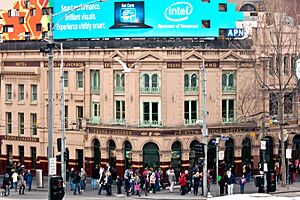
George Coulthard was Carlton's vice-captain in 1882 when an event led to the end of his VFA career. During a training session in April, he had a disagreement with a new teammate. This disagreement continued in August when Carlton played against Hotham. During the game, George and the other player had a physical clash. George was accused of using "bad language." Other players quickly stopped the fight. The crowd then rushed onto the field, and it looked like a big problem might happen until the police stepped in. A newspaper called it "one of the most disgraceful affairs witnessed on a football field."
Six days later, the VFA held a special meeting about the incident at the Young & Jackson hotel. After looking at all the information, the VFA decided that George was "more to blame" for the incident. The chairman said that "bad language is far worse than blows." Both players were suspended for the rest of the season. This was the first time such a severe punishment had been given by the association.
Some people thought the punishment was too harsh for George. They pointed out that he had never been charged with something similar before. They also felt the VFA had been more lenient in other cases. The incident also led to discussions about how the media reported on sports. One journalist was criticized for making the fight sound more dramatic, which some believed influenced the VFA's decision.
Hotham accepted the ruling, but Carlton was criticized for refusing to play their next game unless George was allowed to play. Carlton eventually decided to play out the season. They still tried to get George's suspension lifted. At the VFA's next meeting, the case was looked at again. In a move that made many people upset with the VFA, the other player's suspension was lifted, but George's stayed in place. A newspaper said the VFA's decision was based on "various jealousies and petty personal interests." They called for the VFA to be completely changed. Some believed George was made a scapegoat because he was a professional sportsman from a lower social class.
Even though George missed five games because of his suspension, he still kicked 14 goals. This was the most for Carlton and the fourth most overall in 1882. He never played senior-level football again after this.
Cricket Career
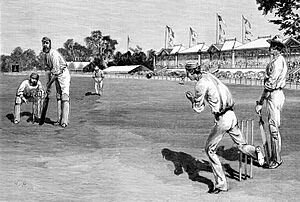
Australia v. England at the MCG, 1879, in the third-ever Test match, umpired by Coulthard
|
||||||||||||||||||||||||||||||||||||||||
| Cricket information | ||||||||||||||||||||||||||||||||||||||||
|---|---|---|---|---|---|---|---|---|---|---|---|---|---|---|---|---|---|---|---|---|---|---|---|---|---|---|---|---|---|---|---|---|---|---|---|---|---|---|---|---|
| Batting | Right-handed | |||||||||||||||||||||||||||||||||||||||
| Bowling | Right arm medium | |||||||||||||||||||||||||||||||||||||||
| Role | All-rounder | |||||||||||||||||||||||||||||||||||||||
| International information | ||||||||||||||||||||||||||||||||||||||||
| National side | ||||||||||||||||||||||||||||||||||||||||
| Domestic team information | ||||||||||||||||||||||||||||||||||||||||
| Years | Team | |||||||||||||||||||||||||||||||||||||||
| 1880/81–1881/82 | Victoria | |||||||||||||||||||||||||||||||||||||||
| Umpiring information | ||||||||||||||||||||||||||||||||||||||||
| Tests umpired | 2 (1879–1882) | |||||||||||||||||||||||||||||||||||||||
| Career statistics | ||||||||||||||||||||||||||||||||||||||||
|
||||||||||||||||||||||||||||||||||||||||
|
Source: Cricinfo
|
||||||||||||||||||||||||||||||||||||||||
Melbourne Professional
George Coulthard started his cricket career at the Carlton Cricket Club. For the 1877–78 season, he moved to the Melbourne Cricket Club (MCC). There, he worked as a professional bowler, meaning he would bowl to members in practice. In 1878–79, he played as a substitute for a Victorian team against the first Australian representative team. He also batted for the MCC when they played against a visiting New Zealand team.
George was only twenty-two when Lord Harris, the captain of the touring England team, decided to try him out as an umpire. This was based on advice from the MCC. George umpired the English team's first game in Melbourne on Boxing Day 1878. He also umpired the only Test match of the tour, which was played against Australia at the MCG in January 1879. Lord Harris was happy with George's umpiring. He invited George to travel with the team and umpire for the rest of their tour.
The Sydney Riot of 1879
The England team's next important game was against New South Wales in Sydney. George was a paid professional, and many people in Sydney were suspicious of him. At that time, local games usually used amateur umpires. Also, there was a strong rivalry between the colonies, and the fact that George was from Victoria made people trust him even less. Some also thought he was too young and new to be an umpire for such big games. Still, New South Wales was expected to win, and many people had placed large bets on them.
The first game went smoothly, with New South Wales winning. England fought back in the second game, which started on February 7. Billy Murdoch, the star player for New South Wales, had scored 82 runs. He was still batting when George Coulthard ruled him run out. This decision caused a huge uproar among the 10,000 people in the crowd. It was said that gamblers in the stands encouraged Murdoch to stay on the field. This wasn't George's first controversial call; on the first day, he had made a mistake by giving an English player a second chance after he was caught.
The captain of New South Wales, Dave Gregory, ignored his own team's umpire, who thought the run out was fair. Gregory threatened to stop the game unless Lord Harris replaced George. While the captains talked, one of the English players made things worse by calling the crowd names. At this point, up to 2,000 "roughs" and "larrikins" (troublemakers) rushed onto the field. Some of the English players grabbed stumps to defend themselves. Lord Harris was hit with a stick while defending George. The mounted police struggled to restore order. They were only able to rescue George after a long effort and with help from volunteers. The game was tried to be restarted twice. But when the rioters found out Lord Harris would not remove George, they rushed the field again and stayed there until the game was supposed to end. Outside the ground, George was surrounded by a mob of 200 people. But a group of sailors stepped in and helped him escape without further trouble.
After officials from New South Wales cricket apologized, Lord Harris agreed to continue the game after the Sunday break. But only if George remained the umpire. England won the game. They then canceled their remaining games in Sydney. The riot was widely reported as a national disgrace and a blow to relations between Australia and England. The Sydney newspapers said George was either bad at umpiring or "wilfully corrupt." George wrote a public letter denying that he had bet on the match. Lord Harris also publicly stated that he would not have hired George if he had suspected him of betting.
At a special dinner for the England team in Melbourne, Lord Harris said he still believed Murdoch was correctly out. He also told the audience that he and his team "had met with no better or fairer umpire than Mr. Coulthard."
First-Class and Test Careers
George Coulthard joined a Victoria team in March 1880 to play against Australia's representative team that season. He took the most wickets for his team, with 5 wickets for 52 runs and 4 wickets for 28 runs. In his first-class debut for Victoria later that year, he played against South Australia. He took 3 wickets for 29 runs and scored 31 runs in the first innings. But his bowling was not as good in the second innings. The next month, George scored 51 runs for a Victorian team against the Australian team. He then played in his first of three first-class games against New South Wales. He didn't have a big statistical impact for Victoria in these games between colonies.
It's a bit surprising that George, who was Victoria's twelfth man (a reserve player), was chosen to play for Australia in the 1881–82 season. This happened after two other players had to withdraw due to injury. It was the second Test match of the tour, held in Sydney in February. Batting at number eleven, he scored 6 not out (meaning he wasn't out) in a useful partnership with another player. This was George's only Test match appearance. This makes him one of the few players to have umpired a Test match before playing in one. Also, by a "twist of fate," his captain in that match was Billy Murdoch, the player he had controversially given out in the Sydney Riot. George umpired the fourth and final Test of the tour at the MCG in March.
Other Sports
Besides cricket and football, George Coulthard was excellent at other sports. People remembered him as "one of the best all-round sportsmen of all time."
He was a respected amateur boxer. He even sparred with and competed against the famous English bare-knuckle boxing champion Jem "The Gypsy" Mace.
Family and Personal Life
George Coulthard was born on August 1, 1856, in Boroondara (near Kew). His parents, Thomas and Elizabeth, had moved to Victoria from England in 1854. George was their seventh child. Both his parents passed away when he was young.
George went to St. Matthew's School in Carlton. As an adult, he lived on Lygon Street in Carlton. He owned a sports shop there, which also served as a clubroom. In July 1880, he married Letitia Ann Jackson. They had two daughters, but one sadly died when she was a baby.
In March 1879, George helped catch a well-known criminal who had avoided capture for five years. George reportedly later became a member of the Victoria detective force. George also donated a koala to the place that would become the Melbourne Zoo in 1880.
George's youngest brother, William, was the only sibling to live past the age of 30. He lived until 1935 and was on the board of the Carlton Football Club. He named his son after George.
Illness and Death
In November 1882, George Coulthard was chosen to umpire for Ivo Bligh's touring England team. This team was on its famous journey to win back The Ashes. George became ill during a sea trip early in the tour. During a match in Newcastle, he felt very unwell and had to leave his post. George had caught tuberculosis, a serious illness. By the start of the 1883 VFA season, people feared he was close to death.
It was decided that all the money raised from a June match between Carlton and Melbourne at the MCG would be given to George. The Melbourne newspapers expected a record crowd because George was so popular. However, stormy weather meant only about 5,000 people attended. Hotham, the club George had a disagreement with the year before, was also among those who donated money to help him.
On October 20, 1883, it was reported that George was "confined to his bed in a dangerous state." As he was very ill, he seemed to talk about his suspension from the VFA. He was heard saying, "It is not true they're going to disqualify me. Surely they won't disqualify me." News of his death on October 22 was met with great sadness from the public. A large procession followed George's coffin from his home to his funeral. He was buried at the Melbourne General Cemetery next to Princes Park, which is the home of the Carlton Football Club.
One sportswriter wrote this about George after he passed away:
In all my experience I never met with one who better deserved to have written for epitaph "He was a man."
A special concert was held later that year in Carlton to raise money for George's wife and daughter. At the event, a local person recited a poem about George, which included these lines:
The foremost he, for football's manly game,
Was ever linked with poor George Coulthard's name.
He never changed—to Carlton always true,
He donned thro' good and ill the same dark blue.
"The Dream"

George Coulthard is also remembered in Australian horse racing history for a dream he supposedly had weeks before he died. The story goes that George, while very ill, dreamt that a horse named Martini-Henry would win the Victoria Derby, and another horse named Dirk Hatteraick would win the Melbourne Cup. He also dreamt that he himself would die before the first race. George's dream became "the great topic of the day" and was widely reported in the news. When he died before Martini-Henry won the Derby, many people who believed in superstitions placed bets on Dirk Hatteraick to win the Cup. This caused the odds for that horse to drop sharply, even though one writer said the horse was "as fat as a bacon hog." Dirk Hatteraick finished near the very end of the race. Even a former member of the Victorian Parliament believed in George's dream, but admitted betting on Dirk Hatteraick "was an idiotic thing to do."
Legacy and Impact
George Coulthard is often considered one of the greatest Australian rules footballers from the first fifty years of the game. In 1908, a sports journalist wrote about George:
He could not be misplaced. His clever handling, his pace, his expertness in dodging, his sureness in the air, and his masterful kicking were items that proved invaluable to his team. He was the brightest star in the galaxy, such as does not, even to-day, shed its effulgent beams on Carlton.
An early football historian named C. C. Mullen later called George Coulthard the "Champion of the Colony" for the years 1876, 1877, and 1879. George was inducted into the Carlton Football Club Hall of Fame in 1990. He is also one of the few players from his time to be a member of the Australian Football Hall of Fame.
George Coulthard is shown in the MCG Tapestry, a large artwork unveiled at the MCG in 2003 to celebrate the ground's 150th anniversary.
A historian named Mark Pennings included George Coulthard as a follower in his "Team of the Nineteenth Century." Pennings wrote that George's natural athletic ability and many skills made him the perfect follower. He was "the player that other teams had to stop."
See also
- Australian Football Hall of Fame
- List of Australian rules footballers and cricketers
- List of Australia Test cricketers
- List of Test cricket umpires
- List of Victoria first-class cricketers


